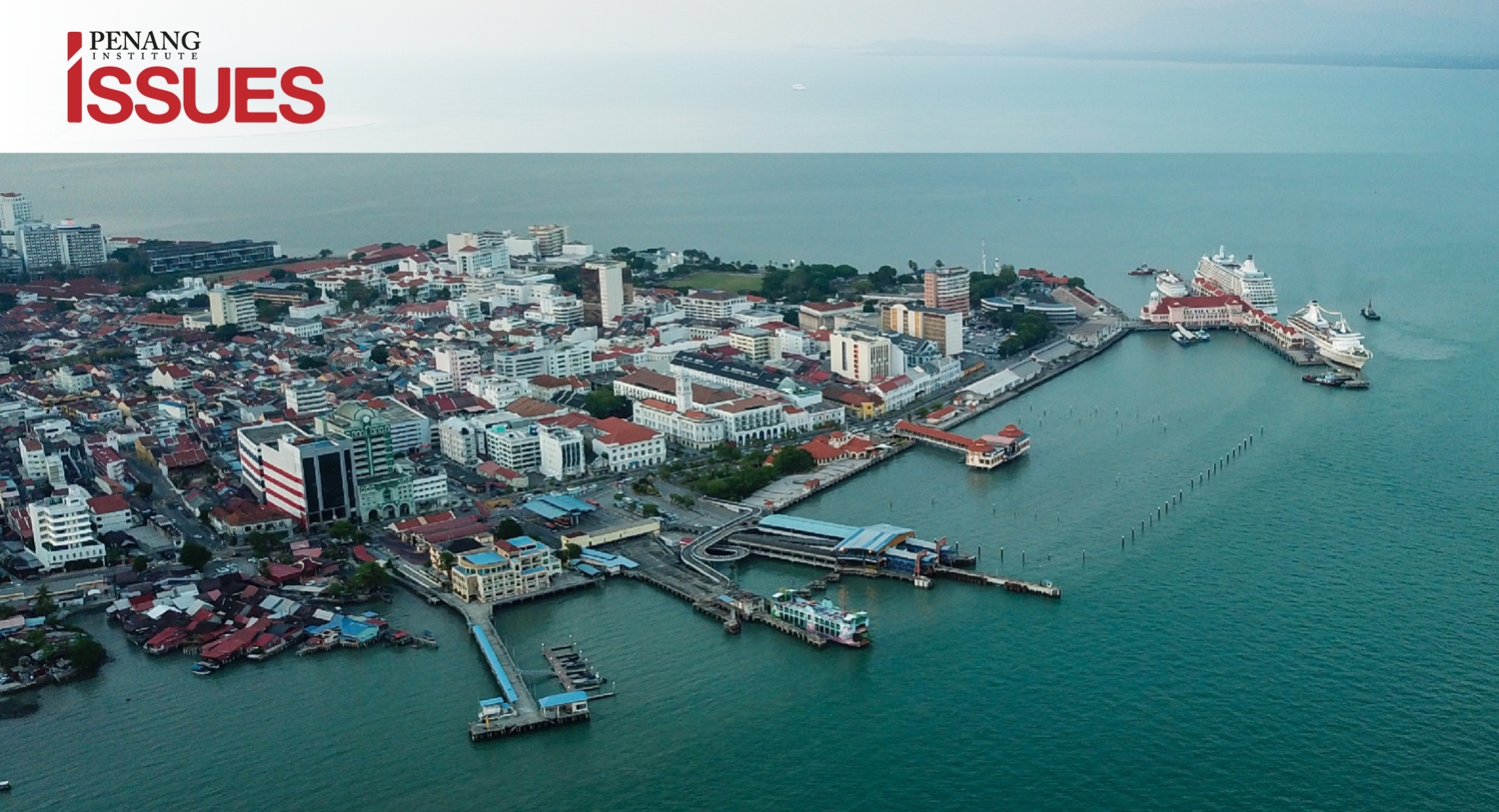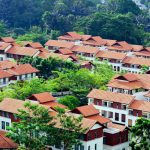
EXECUTIVE SUMMARY
- The global strategic and economic landscape has evolved dramatically over the last three years. Malaysian politics has also been transformed beyond recognition. This presents both new challenges and new opportunities. In that light, Penang Institute decided to ask the heads of Penang state GLCs on what they think the important policy issues and concerns are whic needs immediate attention from the new state government.
- The major finding has been that Penang needs to move up the value chain, especially its manufacturing sector. It will need to explore new areas of economic growth.
- Upgrading education, talent and skills development is considered essential for fostering stronger economic growth and a more confident community.
- Sustainability and climate resilience are the two most cited environmental concerns, with sustainable tourism being at the forefront for tourism development.
- Universal access to childcare is also deemed important for increasing the participation of women in the workforce, and in the cultural development of the state.
- Traffic congestion and public transportation issues are areas that remain challenging for Penang, according to most respondents.
- Closer collaboration between state GLCs and state departments are touted as the easiest way for Penang to cultivate an environment that encourages policy discussion, project synergy and knowledge exchange.
PREAMBLE
Since its inception in July 2023, the Penang State Government’s latest policy direction for economic growth, expressed in the Penang Strategy for Economic Ecosystems Development (SEED), has begun to shift the primary emphasis of policymaking in the state towards fostering supportive ecosystems, promoting inter-agency cooperation, and harnessing the advantages of digitalisation.
The new government now needs to consider the economic dynamics faced by both the nation and the state, given the fast-changing global strategic and economic landscape over the last three years.
Given that state GLCs are important stakeholders in Penang’s development and key supporters of state policies, their strategic concerns and suggestions are essential inputs for directing policy priorities in coming years. In that frame of mind, Penang Institute recently conducted a flash survey among the heads of the state’s GLCs, requesting them to identify issues and areas needing immediate attention from the state government. The following is a summary of the main concerns most frequently raised by the heads across the board:
1. Moving up the manufacturing value chain
The manufacturing sector is the primary economic driver in Penang, accounting for 37.4% of Penang’s GDP in 2021. The state has been steadily reinforcing this sector’s strong position in the supply chains by rebuilding and sustaining the relationships between key trading partners and global chain partners in post-pandemic times.
The electrical and electronics (E&E) industry is particularly vital, as it has been the largest contributor to manufacturing investment over the last 10 years, contributing 71.4% of total investments.[1] Besides E&E, Penang is also a strong regional hub for automation, medical technology and outsourced semiconductor & test (OSAT).[2] However, as the market becomes increasingly competitive with other countries in the region, Vietnam in particular, Penang will have to strategise to maintain its strong regional comparative advantage. In short, it has to consider how it is to move up the value chain and go beyond testing, assembling and packaging, and how best to diversify by leveraging existing strengths.
As it stands, there has been substantial focus on higher value-added segments in recently approved investments, including efforts to strengthen the areas of avionics and renewable energy. The growth of the manufacturing sector for the future is predicted to be centred around the expansion of the supply chain’s forefront, particularly in integrated circuit (IC) design and automation solutions.
Therefore, for Penang’s manufacturing sector to stay connected and relevant within the global value chain, it must persistently pursue and foster innovation, in addition to allocating more resources towards the incorporation of R&D activities. Furthermore, the cooperation and connections between research institutes and businesses within the E&E industry need to be strengthened to amplify the development of components and products. Penang’s current IC design industry should be further enhanced to foster the emergence of new technologies and ventures, so that Penang is able to position itself as a central hub for IC design in Malaysia and the region.
2. Exploring and strengthening new economic growth areas
Although Penang’s economic sectors remain robust and resilient in the post-pandemic era, particularly the manufacturing and services sector, it is still important to continually explore potential new economic growth areas. A heavy reliance on a few industries and sectors leaves the state economy vulnerable to economic downturns and industry-specific global market fluctuations. Diversification into new economic growth areas can help Penang reduce its dependency on specific sectors, mitigate the impact of economic shocks and increase its economic resilience. Additionally, the development of new economic sectors will lead to job creation, providing more employment opportunities for the local workforce.
The halal industry is exactly such a potential growth area for Penang’s economy, given that the halal consumer market covers approximately 42% of ASEAN countries. Penang’s halal industry is already actively engaging in international trade, exporting halal-certified products to various countries, especially those where the Muslim population is significant. As the industry expands, it could potentially lead to more research and development in halal manufacturing and processing, and in other sectors such as halal tourism. In addition, Penang stands to benefit from building a strong ecosystem to cultivate halal entrepreneurs and SMEs that are able to enter and compete in regional and global markets.
The digital economy is another prospective area where growth can be enhanced. A more robust digital economy will revolutionise the state’s economic ecosystem. Developing short-term (community programmes) to long-term (special investment funds) plans on empowering startup and innovation hubs to attract out-of-state and foreign startups would foster entrepreneurship, innovation and invention, and consolidate the digital startup ecosystem to leverage on Penang’s existing advantages in the logistics and supply chain.
3. Education, talent and skills development
The swift pace of technological evolution and the progress in automation technology calls for a comprehensive strategy for enhancing talent and skills development. Not only should Penang’s workforce be capable of responding to rapidly evolving skill demands, it should be able to anticipate future needs and be well-equipped to face new challenges.
A 2020 study by Penang Institute found a low level of interest in STEM subjects among higher secondary students and tertiary education students.[3] This is a major concern to the industrial sector, given its need for high-skilled workers in STEM areas. The foundation for STEM education urgently needs to be strengthened, beginning from primary and early secondary levels, and interest for STEM subjects cultivated among students. TVET education as a pathway to develop technical and professional skills should be emphasised as well. Adding on to that, more programmes and initiatives should be initiated to generate greater exposure to STEM career opportunities for students, teachers, parents, and the community. Awareness programmes regarding future job opportunities are needed, and Penang’s existing companies should be in the forefront of this information campaign. In addition to that, a platform to coordinate placement programmes for school and higher-education graduates into work-integrated learning programmes would be highly beneficial in preparing Penang’s students for the workforce.
Equally essential is the development of talent and skills within the current workforce. In addition to fortifying and upgrading existing skills, talent and skills development will close any skill gaps currently existing in the workforce. Through the implementation of training and upskilling programmes, Penang can effectively tackle any deficiencies in key areas, and align itself with the specific needs of its industries. Public-private partnerships can be established and/or expanded to provide more training and upskilling opportunities, and facilitate reskilling towards higher-value jobs.
In order to prepare Penang’s workforce for the digital and artificial intelligence era, it goes without saying that a culture of creativity and innovation in skills and talent development needs to be fostered. This requires collaborative efforts from the federal and state governments, state agencies, education institutions and the private sector.
4. Sustainable tourism development
The rejuvenation of Penang’s tourism sector had been promisingly steady since the reopening of international borders. As the industry moves forward, the idea of sustainable tourism development should be at the forefront for all stakeholders and industry players, as Penang has great potential to become leading hub for sustainable and responsible tourism.
As a start, Penang’s hotel industry should actively be thinking about improving its sustainability in terms of reducing energy and water consumption, minimising food waste, and supporting the local community by sourcing local and organic products. These practices should be fostered among the hoteliers, their staff as well as guests. Green building design principles should be adopted wherever possible; energy consumption can be significantly reduced by incorporating features such as solar panels, efficient insulation and natural lightning.
Penang is home to a vast network of beaches, large forest reserves, natural hills and parks as well as mangrove forests, which could be showcased as prime ecotourism destinations. There are great opportunities for the state to nurture and boost sustainable tourism by capitalising on its abundant natural assets and resources. The maintenance of these natural assets will be vital in the development of sustainable tourism, it is therefore important to continually upgrade, conserve and preserve the beauty of Penang’s natural environments. As an example, the environmental conservation and the overall cleanliness of Penang’s beaches need to be upgraded, by way of implementing shoreline protection measures and strict waste management practices.
Sustainable tourism development in Penang will involve responsible planning, management, and promotion of tourism activities, while preserving the cultural and natural heritage of the state. Moving ahead, it is essential that the state prioritises sustainable tourism practices and discourses in its tourism development endeavours.
5. Upgrading childcare access and services to foster higher participation of women in the workforce
Penang’s female labour force participation rate (FLFPR) has always been historically low. In 2022, the FLFPR was 56.7%, which was 27% lower than the male labour force participation rate. Childcare, care work and domestic work are among the primary reasons why women drop out of the workforce after their childbearing years, and do not return to the workforce even after their children have grown.[4] A lack of accessible and affordable childcare further worsens this conundrum.
Ensuring that parents, especially women, have easy access to childcare services and childcare choices is vital in enabling them to seek employment opportunities that enhance their family’s financial well-being and stability. Affordable childcare enables women to participate in the workforce and maintain career continuity, which is highly important for their career advancement and job security. Higher rates of FLFPR brings positive spillover effects on economic growth while narrowing the gender pay gap at the same time. This also raises their social status as well.
Among the most commonly identified issues in childcare that needs improvement are accessibility, affordability, safety and quality of curriculum. Parents have cited difficulties in accessing comprehensive information on location and availability of childcare centres, in addition to concerns regarding the safety of the centres and the quality and professionalism of existing childcare givers. High costs of childcare also pose a barrier, which women see as an economic disadvantage in returning to work.
These challenges must be summarily addressed; universal access to affordable and quality childcare services should be regarded as a fundamental right rather than merely a privilege for some. Furthermore, high-quality childcare is significantly beneficial for the social and cognitive development of children.
6. Addressing traffic congestion and public transportation issues
Traffic congestion was frequently raised as one of the major challenges for Penang. There is no doubt that effective road networks and a streamlined public transportation system are essential prerequisites for widespread mobility and accessibility; these also play pivotal roles in driving economic growth and enhancing efficiency across various economic sectors. The alleviation of road congestion and traffic issues is also essential in ensuring improved mobility and livability for the local population.
It was suggested that traffic monitoring and analytics should be strengthened for better decision-making, especially with regards to traffic control during peak hours on high usage routes. Technology (e.g. traffic sensor, GPS tracking) should be more widely utilised in gathering real-time data from locations experiencing high volumes of traffic and congestion in order to gather the most comprehensive information on traffic flows, volumes and speeds.
Introducing designated bus lanes and dedicated parking areas for tour buses were additional strategies that can reduce traffic congestion. Additionally, both government and private sector entities might explore the possibility of staggered work hours as another means of mitigating heavy traffic volumes.
Improving the availability and efficiency of public transport delivery to achieve a streamlined public transportation system would also have significantly positive effects on Penang’s livability. Therefore, the overall performance of the public transportation system should be monitored closely, specifically the delivery of services and connections to high-density areas such as residential areas, places of employment and essential tourist spots. Additionally, the bus routes with high usage should be comprehensively analysed when considering ways to upgrade and expand the delivery of services. Last-mile connectivity issues should be summarily addressed to ensure the existing gaps are bridged.
As it stands, the mitigation of traffic congestion and public transportation issues in Penang will require concerted and collaborative efforts between all stakeholders, including the enhanced integration of local planning with traffic and public transportation needs.
7. Enhancing climate change resilience
Climate change resilience is of critical importance for Penang, as the state faces unique challenges due to its coastal location, rapidly urbanising landscape, and varied economic activities. Penang is particularly susceptible to rising sea levels and extreme weather events such as storms and typhoons. The impact of climate change amplifies the likelihood of coastal erosion, flooding, and saltwater intrusion, which can result in severe consequences for the state’s communities and infrastructure. Additionally, the effects of sea-level rise extreme weather patterns and other climate-induced natural disasters on key economic sectors and vulnerable populations need to be assessed and mitigated.
Forming a Climate Resilience Committee would be one way for the state government to begin addressing climate challenges. This Committee can be assigned the responsibility of enhancing Penang’s resilience to the effects of climate change in the social, economic, and environmental dimensions. This can be accomplished by setting baselines and benchmarks, identifying key focus areas, and ensuring that all government-level development plans include a mandatory strategic impact assessment for land use planning.
The Committee could also play a role in the establishment of a sustainability policy for the state government, emphasising resource use and allocation efficiency and the reduction of carbon footprints, among addressing other climate resilience issues. Urban planning should take sustainable practices into account, for example, prioritising green spaces and encouraging energy-efficient buildings that include the installation of solar panels.
The state also needs to strengthen food security measures by looking into alternative food security measures to combat climate change risks on traditional crops. It is also suggested that the state’s sources of water and electricity be diversified as a strategy for enhancing resilience and security in resource management and protecting against sudden disruptions.
As a whole, climate change resilience is imperative for the preservation of the environment, the well-being of individuals, and the enduring sustainability of both economies and communities. Building resilience is a proactive and forward-looking approach in addressing the complex challenges posed by climate change.
8. Closer collaboration between state GLCs and state departments
A close cooperative relationship among government-linked companies (GLCs) in Penang holds significant relevance for both the state government and the broader economy. Penang’s GLCs are often highlighted for their strength and influence within the industrial, economic and social spheres, and stronger collaboration between them will foster the ability to combine resources, exchange knowledge, and allocate investments towards initiatives that yield favourable outcomes for the economy. These collaborative efforts can result in the generation of employment opportunities, heightened productivity and professionalism, and the advancement of overall economic growth.
Additionally, state GLCs and state departments should also work on forging a more robust relationship. The effectiveness of current and future state policies can be streamlined by setting up a platform to coordinate the strategies and programmes of the state GLCs and the civil service to strengthen existing programmes and avoid programme duplications. They could also work closer together to identify areas for strategic collaboration to optimise the efficacy of policies. The development of alliances and partnerships between state GLCs and state departments could be further enhanced through networking activities and shared capacity-building programmes. Furthermore, heightened collaborative efforts can lead to better coordination and improved information flows, resulting in more effective public services, streamlined regulatory processes, increased ease of doing business, and better governance.
Effective collaboration depends on a shared vision, transparent communication, and a steadfast dedication to the wellbeing and welfare of the people
Conclusion
Moving forward, strategic policymaking is essential for efficiency, transparency and consistency in government actions. It will also serve to ensure optimal economic development for Penang, as well as improve the well-being of its people and the livability of Penang as a whole.
For list of references, kindly download the document to view.
Editor: Ooi Kee Beng
Editorial Team: Alexander Fernandez and Nur Fitriah (Designer)
[1] Calculated from data provided by Malaysian Investment Development Authority (MIDA)
[2] Towards High Value Manufacturing, Penang SEED (2023)
[3] Penang Institute. (2020). Students’ Choice of STEM study in secondary and tertiary education in Penang, retrieved from https://penanginstitute.org/wp-content/uploads/2021/01/Students-Choice-of-STEM-Study-in-Secondary-and-Tertiary-Education-in-Penang.pdf
[4] 2021 and 2022 were exceptions to the rule, as FLPR increased at ages 40-44, after dropping at ages 30-34. Whether this trend is a result of the pandemic and whether would it sustain in the coming years remains to be seen.
You might also like:
![Stringent MM2H Requirements Mar Malaysia’s Record as Preferred Destination for Long-term Residence]()
Stringent MM2H Requirements Mar Malaysia’s Record as Preferred Destination for Long-term Residence
![Obesity in Malaysia: Unhealthy Eating is as Harmful as Smoking]()
Obesity in Malaysia: Unhealthy Eating is as Harmful as Smoking
![TVET in Malaysia: Current Situation, Challenges and Recommendations]()
TVET in Malaysia: Current Situation, Challenges and Recommendations
![Realising Blue Economy Benefits in Penang]()
Realising Blue Economy Benefits in Penang
![A Review of Malaysia’s Progressive Wage Policy White Paper]()
A Review of Malaysia’s Progressive Wage Policy White Paper






